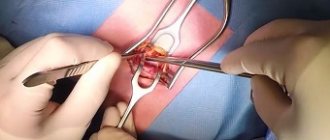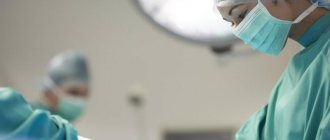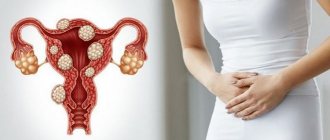Purpose of visit to a mammologist
A mammologist is a doctor who specializes in examining and treating diseases that occur in the mammary glands. At first glance, it may seem that there are very few reasons to visit such a specialist, and the need for this arises in a small number of women.
In fact, you need to go to an appointment in many cases:
- when palpating a tumor in the breast
- if during self-examination there is a feeling of discomfort
- when a questionable fluid is released from the nipples
- with deformation of the nipples or breasts
- before the start of the menstrual cycle, severe pain is felt in the mammary gland
It is recommended to undergo an examination by a mammologist at least once a year, and not only when any abnormalities, deterioration or discomfort appear. In addition, breast self-diagnosis should be performed monthly to detect changes in a timely manner.
Many women are also interested in when is the best time to go to a mammologist for the first time. Experts say that examination should begin from adolescence, from the first menstruation until old age.
In what cases is urgent examination required?
An examination by a mammologist during the prescribed phase of the cyclic period allows you to obtain more accurate information about the condition of the female breast. However, there are situations when an urgent appointment with a mammologist is necessary on any day of the cycle. These circumstances, first of all, include unusual discomfort in the mammary glands, which has never manifested itself before.
So, the reason for an immediate visit to the doctor’s office is the manifestation of the following symptoms:
- Constant pain in the glands, manifested regardless of the cycle.
- Breast deformation and nipple retraction.
- Hyperthermia due to discomfort in the glands.
- The presence of non-specific fluid from the nipples, accompanied by several other signs mentioned above.
- Manifestation of lactostasis or relapse of mastitis.
- There are obvious symptoms of the development of inflammation in the breast.
- Breast injury or infection.
If such a clinic is available, it is necessary to seek medical help as quickly as possible. Self-medication and delaying professional medical examination are dangerous due to the development of complications and exacerbation of the existing pathology.
True, there are a number of clinical signs when a visit to the doctor can be postponed until the right day:
- Self-examination of the breast revealed small compactions and nodules.
- The exudate released from the nipples is colorless, palpation is painless and there are no other signs.
- Swelling of the axillary lymph nodes is observed.
- There is peeling or redness of the skin on the chest.
- The pain is not acute and intensifies before menstruation.
If such symptoms occur, it is better to call the clinic and ask the staff to record a planned visit to the doctor.
What days are best to visit a doctor?
During the menstrual cycle, the mammary gland changes due to the influence of hormonal levels on it. Therefore, not all days are suitable for visiting a doctor. Some of them will be favorable, and the diagnostics performed will provide the most reliable data, while others can greatly distort the result and will be inaccurate.
Calculating which day of the cycle to go to the mammologist is quite simple. Add five to seven days to the beginning of bleeding - the first day. That is, on the fifth day of menstruation and the next two days - the sixth and seventh - it is best to undergo an examination. During this period, the hormonal background is most calm and almost no physiological changes are observed, which means that any pathologies will be most noticeable and noticeable.
Optimal days for examination by a mammologist
So, when is it better to go to a mammologist and on what day of the cycle, how to correctly calculate the required period for a breast examination? In order to determine the favorable time for going to the mammologist, you should add the number “5” to the first day of the onset of menstruation, that is, the fifth and subsequent sixth and seventh days are considered the most optimal for a visit to the doctor.
On this day and the next two days, the hormonal state is suitable for breast cancer research. It is during this period of time that all pathological changes are visible in the chest, which allows an accurate diagnosis to be made.
Experts explain why you need to go to an appointment on days 7-14 of the cycle with the following features of the state of the woman’s body:
- There is a low concentration of hormones that provoke inflammatory processes.
- Reducing the levels of these hormones makes breast examination easier.
- The intensity of physiological changes in the breast is low.
- The patient's health is much better than in other cyclic phases.
At the same time, experts note:
- If you visit a doctor during ovulation or before menstruation, then in this situation the error of hardware research will be too large, and the result of examination and palpation of glandular tissue will be false.
- Significant deviations in the examination results during periods of sharp surges in hormones are explained by the expansion of the milk ducts and swelling of the breast, which can be mistaken for an abnormal condition.
Hormone surges affect the physiological processes in the glands, so the result of examination at different periods of the cycle varies significantly.
At the onset of menopause
On what day of the cycle should I go to the mammologist and when is an urgent examination required after menopause?
For women of menopausal age, with the final completion of the monthly cycle, the body begins to suffer from hormonal imbalance. In this situation, you can check the condition of your breasts any day of the week.
It is also recommended to undergo an examination annually, which will help to promptly identify the development of abnormal processes and take appropriate therapeutic actions.
During pregnancy
Pregnancy and breastfeeding place additional stress on a woman’s breasts. After conception, some processes are launched in the structure of the mammary glands, leading to characteristic changes in their condition:
- Breast volume is growing.
- The color of the nipples changes.
- The glands rise and begin to “stand.”
- The sensitivity of the breast increases.
- Colostrum begins to be released.
- Formation of stretch marks in the chest area.
- The shape of the nipples changes.
- The venous network is illuminated.
All these physiological changes are completely normal, indicating that the body is preparing for motherhood.
It is useful for pregnant women to prepare their breasts for future breastfeeding in advance. Therefore, you should visit a mammologist who will tell you how to care for the mammary glands, how to prevent stagnation of milk and other troubles.
You can see a doctor any day of the month. If necessary, the expectant mother will be prescribed a full examination of the bust to exclude pathological processes, because pregnancy can provoke rapid growth of the tumor.
In the absence of menstruation before and after completion of breastfeeding
It is imperative to visit a mammologist after childbirth, regardless of whether the mother wants to maintain lactation or prefers to switch to artificial formula.
The following factors should serve as a reason for an urgent examination of the breast after the birth of a baby:
- There are difficulties with feeding.
- Before pregnancy there were diseases of the breast.
- Cracks appeared on the nipples.
- There are signs of lactostasis.
- Symptoms of a lactation crisis are noted.
- For medical reasons, it is necessary to quickly stop breastfeeding.
In addition, examination by a mammologist is also necessary for those women who have:
- Prolonged absence of the menstrual cycle or it is incorrect.
- Discharge of cloudy colostrum one year after completion of lactation. The presence of such fluid is a sign of increased prolactin levels or fibrocystic mastopathy.
- The flow of amber or bloody exudate from the nipples is a symptom of intraductal papilloma or malignant tumor.
If everything is normal with the body, and a woman during pregnancy or lactation is not bothered by any abnormal phenomena in the mammary glands, then it is better to go to the doctor 2-3 months after completion of breastfeeding.
In addition, another important nuance should be noted: after completion of lactation, if the menstrual cycle does not occur, a breast examination by a mammologist should be done no earlier than three months later. Since the resumption of menstruation is initially a hormonal process, their recovery period depends on the characteristics of the state of hormones and the hormonal system itself.
How long does it take for hormones to completely change? Usually it should take about 2-6 months, but it all depends on the individuality of the female body. At the same time, doctors note that an earlier onset of the cycle indicates an insufficient presence of the hormone prolactin, which inhibits the production of estrogen.
Experts highlight the following features of the return of the monthly cycle in nursing mothers:
| Features of the flow of hot water | Hormonal recovery time |
| The baby is fed exclusively with breast milk throughout the day and on demand. | Menstruation occurs after the end of breastfeeding. |
| Breastfeeding is combined with complementary foods. | Menstruation can also come if there is lactation. |
| From the day of birth, the child receives mixed nutrition (breast milk and artificial formula). | The monthly cycle resumes 3-4 months after delivery. |
| The child does not receive breastfeeding at all. | Menstruation appears 10-12 weeks after birth. |
What does a mammologist treat?
Breast diseases are divided into three groups:
- inflammatory, which lead to the development of mastitis
- tumor lumps, which include fibroadenoma, lipoma, sarcoma and oncological neoplasms
- arising due to hormonal imbalance, for example, mastopathy, gynecomastia and others
Every year there are more and more breast diseases, and they are increasingly observed in young people. This is due to an unhealthy lifestyle: smoking, reluctance to exercise, drinking alcohol, poor nutrition, eating fast food and other heavy foods that negatively affect the body, etc.
Why should you visit a mammologist?
A woman's breast can become the site of many diseases, sometimes life-threatening. A mammologist is engaged in identifying such pathologies and treating them.
You need to visit such a specialist from adolescence to old age. You should not go to the doctor when your chest hurts, becomes engorged, or has other discomfort. Preventive examinations are mandatory for every woman once a year.
The fairer sex also needs to periodically examine her breasts on her own. You need to urgently go to a mammologist in the following situations:
- if a lump is felt in the chest;
- the mammary gland hurts a lot before the onset of menstruation;
- there is discomfort during self-examination;
- pathological discharge from the nipples appears;
- breasts and nipples were deformed.
Urgent cases
It is necessary to immediately contact a mammologist if the following disorders and changes are observed in representatives of the fair sex:
- chest pain that is independent of the monthly cycle
- inverted nipple
- the temperature rises and pain is felt in the mammary glands
- the shape of the breast changes;
- discharge appears from the mammary glands
- lactostasis and mastitis occur
- inflammatory process
- infection
- injury
All these symptoms and problems can lead to the development of severe complications and lead to dangerous consequences.
In some cases, if alarming signs of illness appear, it is not necessary to go to the doctor immediately. For example, if there is discharge and there is no pain in the chest area, it would be more appropriate to make an appointment on days favorable for the examination.
What tests should I go to the doctor with?
You can go to the appointment without tests if you are healthy. An examination and, if necessary, an ultrasound and mammogram are sufficient. What tests should you go to a specialist for if you experience discomfort during menstruation or feel lumps? The following results will help make a diagnosis:
- blood test for hormones: ovarian (FSH, progesterone, estradiol) and thyroid (TSH, T3, T4);
- Ultrasound of female genital organs (ovaries, uterus);
- gynecologist consultations;
- cytology of nipple discharge.
If you come to the doctor without the results of these tests, the doctor will write a referral for the necessary examinations.
With this, we say goodbye and invite you to visit our website if new questions arise about women’s “weapons” - the breasts. Share interesting information with friends using the share button via social networks.
A visit to a mammologist is a mandatory periodic procedure for every representative of the fairer sex. But you need to come to such a doctor’s office on specially designated days. After all, the female body undergoes some changes as a result of cyclical changes in the level of sex hormones. This can significantly distort the results of the examination. Therefore, it is important to know which day of the cycle to go to the mammologist.
How is the appointment going?
An examination by a mammologist begins with a conversation with the patient. The doctor collects anamnesis, finds out from the girl what complaints she has, what problems she has, what worries her. After the survey, the specialist checks by touch for the presence of nodes and seals.
We must not forget that an urgent visit may give an unreliable result. In the first days of bleeding and the period of ovulation, due to a hormonal surge, the examination may not be accurate. A woman may feel pain upon palpation. The most suitable days for diagnosis are the fifth – seventh day of the menstrual cycle. These days, the specialist sends the patient for an ultrasound scan.
Women over 40 years old are prescribed mammography. This diagnostic method is more reliable for this age. In addition to a mammologist, a breast examination can be performed by a surgeon, gynecologist or oncologist.
When a pathology is detected, the woman is prescribed additional examination methods to make an accurate diagnosis:
- ductography (breast x-ray)
- MRI
- CT
- scintigraphy
- tests: blood, urine, nipple discharge, puncture of the tumor and its study using an ultrasound machine
After an accurate diagnosis of the disease, the patient is prescribed a course of treatment. The patient may need to consult other specialists.
If the disease is not confirmed, the woman is strongly recommended to conduct a self-examination of the mammary glands, monitor her diet, and include foods rich in vitamins and microelements necessary to maintain normal hormone levels.
Optimal days to visit a doctor
To determine the correct time to go to the doctor, you should add five more to the first day when the cycle began. The fifth day and the next two days are perfect for examining the mammary glands. It is during this time period that all unhealthy changes can be seen and an accurate diagnosis can be made.
These days are distinguished by the following features:
- low content of hormones that provoke inflammation;
- lowering hormonal levels, which makes breast examination easier;
- minimum physiological changes in the gland;
- good health, better than on other days of the cycle.
The discrepancy between the examination results on days of sharp changes in hormonal levels is due to the expansion of the milk ducts and breast swelling, which can be mistaken for pathology. Hormone fluctuations change the condition of the breast, so the results of the examination at different periods of the female cycle differ significantly.
In the process of attenuation of reproductive functions, the body begins to suffer in terms of hormone production. During menopause, a breast check can be scheduled on any day.
Visit to a mammologist after childbirth
During pregnancy and lactation, a woman’s body undergoes serious changes, including the mammary glands. Therefore, during this period it is necessary to go to a mammologist for an appointment.
Along with the examination, the doctor tells the patient:
- how long should feeding last?
- how to detect problems during lactation
- how to determine if a mother is ready to breastfeed
Completion of lactation is also one of the reasons to visit this specialist’s office, because when transferring a child to artificial nutrition, serious complications are also possible.
But even during feeding, problems cannot be ruled out, for example, lactostasis, which is caused by stagnation of milk due to poor sucking by the baby, or improper attachment of the baby to the breast. If you do not seek help from a doctor in time, mastitis develops within a few days, which is quite difficult to treat.
To whom and why are periodic examinations by a mammologist important?
You should visit a “breast specialist” regularly once a year for examination:
- teenage girls;
- healthy women.
Women should make an appointment more often, at least once every six months:
- after 40 years;
- with benign tumors of the mammary glands, including mastopathy;
- registered after treatment for cancer of the glandular tissue of the bust;
- with hormonal disorders.
Expectant mothers during preconception preparation and women after the end of breastfeeding should definitely make an appointment with a doctor.
Why are regular checkups necessary? To maintain the health of the bust, to notice and treat emerging breast diseases in the early stages, to avoid severe pathology and even death (if a cancerous tumor grows in the tissues).
When do you need to urgently go to the doctor?
There are situations when you shouldn’t wait for the right moment to visit a mammologist. You need to see a doctor urgently in the following circumstances:
- Prolonged pain in the mammary glands, independent of the monthly cycle.
- Change in breast shape, nipple retraction.
- Abnormal discharge from the nipple, accompanied by one of the above symptoms.
- Increased body temperature combined with discomfort in the breast area.
- The development of an inflammatory process in the chest, as well as the appearance of infection or injury.
- The occurrence of lactostasis or exacerbation of mastitis.
Changes in the condition of the breast depending on the phase of the cycle
A woman’s mammary gland reacts sharply to changes in hormone levels depending on the phase of the monthly cycle, which includes the following stages:
- Follicular. During this phase, the level of follicle-stimulating hormone in the body, which is responsible for the development and maturation of the follicle, increases.
- Luteal. Luteinizing hormone stimulates the secretion of sex hormones in the follicles and causes ovulation.
- Prolactin. During this period, prolactin levels increase, and the mammary glands prepare for lactation.
The most changes in the breasts occur during the luteal phase, when the content of progesterone increases; this hormone is responsible for preparing the female body for conception, pregnancy and birth of a child.
Because of this, some women, 7-14 days before the onset of menstrual bleeding, notice the appearance of:
Advice from a dermatologist... Itching, rashes and flaking of the skin signals that the body is SCREAMS at the top of its lungs about problems. We asked the chief physician, Sergei Vladimirovich Rykov, what these symptoms indicate...
- pain in the chest;
- increase in the size of the mammary gland;
- increased sensitivity of the breast;
- local hyperthermia of the skin.
These symptoms are due to the development of alveoli, which are necessary for lactation if pregnancy occurs. But if conception does not occur, then progesterone is released for 12-14 days, and these signs disappear before the start of the next new cycle.
Swelling of the mammary glands before menstruation, a slight change in their shape and an increase in their size, an increase in their sensitivity during menstrual bleeding is a physiological norm, but when a woman experiences severe pain, high fever and general health suffers, she needs to immediately go to the hospital.
Every female should undergo a preventive examination by a mammologist once a year, after the onset of menarche, and not only when pain and other unpleasant symptoms are observed.
How to do a mammogram
Standard ultrasound of the mammary glands differs from mammography in that the breast is exposed to X-rays, while the mammary gland is clamped with special plates. Having chosen the desired period, the woman goes to the procedure, which consists of the following stages:
- Upon entering the office, the radiologist will ask the patient to remove all items to the waist. It is also necessary to remove all jewelry and metal objects located from the waist and above. If the patient's hair is too long, it will be asked to be pulled up.
- The patient approaches the device and stands as the doctor tells her. The woman's breast is pressed between two plates and an image is taken.
- After this, the breast is released and the patient can get dressed. The duration is 10–15 minutes, a few more minutes are spent on the doctor drawing up a conclusion.
Some women do not want to undergo the examination because it may be painful. The breasts are compressed quite strongly by the plates, which causes discomfort in the woman. There is no need to panic in advance; the perception of the procedure will depend on how the patient herself is prepared to carry it out.
Mammologist appointment
When starting an examination, the doctor first talks with the patient, finding out what problems she is complaining about. The mammologist will collect anamnesis and then palpate the breast, identifying nodules and dense areas. During a routine visit, the doctor will give a referral for an ultrasound if the woman is under 40 years old or a mammogram if she is older.
If there is a suspicion of the development of the disease, the doctor will direct the woman to undergo blood tests - general, biochemical, serological, hormone tests, examination of nipple discharge, puncture if a neoplasm is detected.
If you have doubts about the diagnosis, you need to undergo additional hardware tests:











